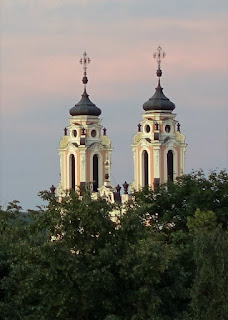I can see our house from her...oh, never mind
The local news this week has been somewhat alarming. No, the Russian army isn't preparing to roll across the Belarusian border, nor is the Ignalina Nuclear Power Plant about to make like its cousin in Chernobyl. No, according to the Baltic News:
...geologists say that the Gediminas Hill and,
therefore, the Gediminas Tower on top of it, can collapse in the very
heart of Vilnius due to landslides caused by melting snow after
especially cold winters, and from tropical rains which now attack
Vilnius from time to time during the current heat wave.
Other reasons given for the instability include theft of stones from the hill's reinforcements, the vibration of tree roots in winter and the tunnel built by the Nazis during World War II (though it was filled in with soil after the war). The situation is apparently serious enough that the country's culture minister has called for the municipal government of Vilnius "to declare an emergency situation over the disintegrating hill of Gediminas Castle", though the local government's Emergency Situations Committee has determined there are no grounds for declaring an emergency, an assessment echoed by the National Museum of Lithuania, which sits at the foot of the hill at issue.
So what does one do when faced with the possibility of one of the city's most iconic sights being closed in the near future? You hurry up and visit it at the earliest possible opportunity, that's what. But not before first having a salmon-and-cream cheese crepe at the Pilies kepyklėlė bakery on Pilies gatvė:
Returning to Pilies gatvė after lunch, Gediminas Hill and its iconic red-brick tower immediately come into view:
The hill stands 48 meters (157 feet) high and was the location upon which Vilnius was founded. Overlooking the junction of the Neris and Vilnia rivers, settlements and forts have been built on the site since Neolithic times. A red-brick building has sat atop the hill since the 13th century, but the current structure has its origins in 1419 when, according to legend, Grand Duke Gediminas, while on a hunting trip, had a dream of an iron wolf howling from the hill. The duke's pagan priest interpreted the dream as a sign that a strong fortress should be built on the site. The original tower was one floor higher than the 20 meter (66 feet)-high building that occupies the hilltop today. The walls fell to ruin when the Russians occupied the city from 1655 to 1661, but were restored in 1930 to house the Upper Castle Museum. Further restoration work took place in the 1950's:
48 meters isn't a great distance to climb, but seeing as my wife is averse to most forms of exercise, the three of us made use of the funicular to the top of Gediminas Hill. Note the tarp covering part of the hillside:
The museum inside the castle contains the usual history exhibits, including scale models, as well as armor and weapons:
Another exhibition covers the Baltic Way, when two million people joined hands in a human chain that spanned 676 kilometers (420 miles), starting in Vilnius (Lithuania), going through Riga (Latvia) and ending in Tallinn (Estonia). It was held on August 23, 1989, the 50th anniversary of the infamous Molotov-Ribbentrop Pact which sealed the fate of the three Baltic republics as independent states in the spring of 1940. The Baltic Way was also a stunning show of defiance against the Soviet Union, and seven months later Lithuania would declare its formal independence from the U.S.S.R.:
The 360°-views from the roof of the castle are impressive, particularly those of Vilnius' Old Town:
The Lithuanian flag flying freely and proudly from the top of the castle:
A look back at Gediminas Castle & Museum as we started to head downhill toward Cathedral Square:
At the bottom, and taking an ice cream break:
Strolling along Pilies gatvė again, which on weekends is lined with souvenir vendors and street musicians, at least in the summer months:
According to Lonely Planet, "Lithuanian folk art is alive and well" in the folk artists' workshops scattered around Old Town. Senųjų Amatų Dirbtuvės is a combination store/hands-on workshop affiliated with the Fine Crafts Association of Vilnius. We picked up a few keepsakes to place on our rapidly-diminishing shelf space at home:
Amber turns away after reading a sign explaining the history and location of Vilnius' WWII Jewish ghetto:
Sunday (today) was also a day of vistas, albeit limited ones. While Shu-E was attending a party, my daughter and I broke out the bikes for the first time since they were delivered to our apartment in Vilnius. The two of us rode over the bumpy cobblestones of Old Town, dodging tourists and vehicles, to reach a lookout point close to Amber's school. The sky wasn't as clear as it was yesterday, but it felt good to be back on the bikes. Mine needs to have its gears checked, but hopefully we can get a few more rides in before the sun disappears and the streets get covered in salt:
With my wife still at her party, my daughter and I ended our day at Boom Burger, where the burgers are kind of cheesy (and required the use of a fork and knife to consume), but the beer is local and micro:

























































